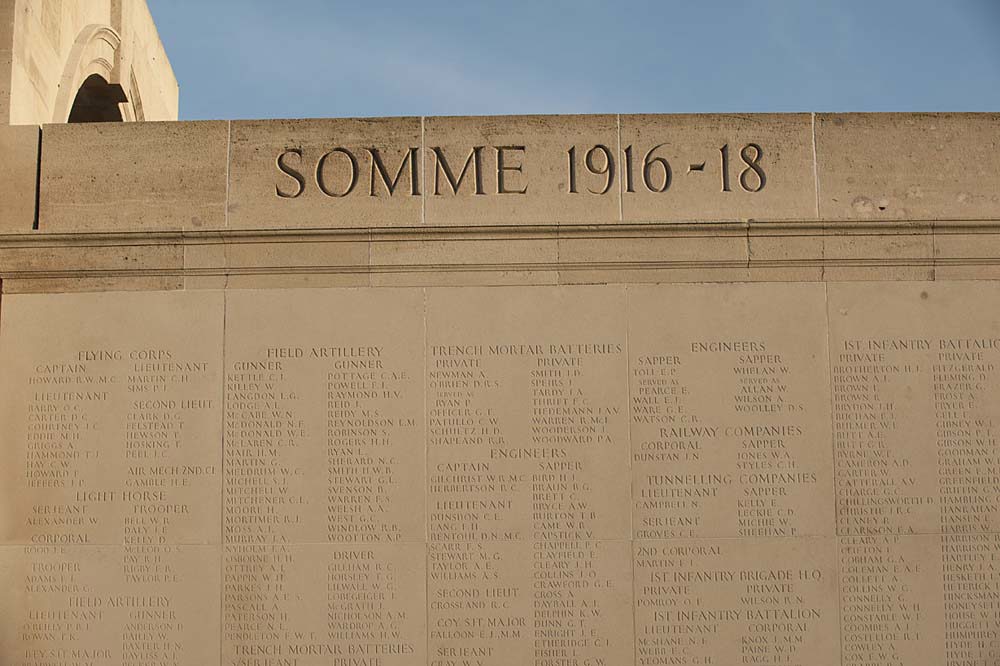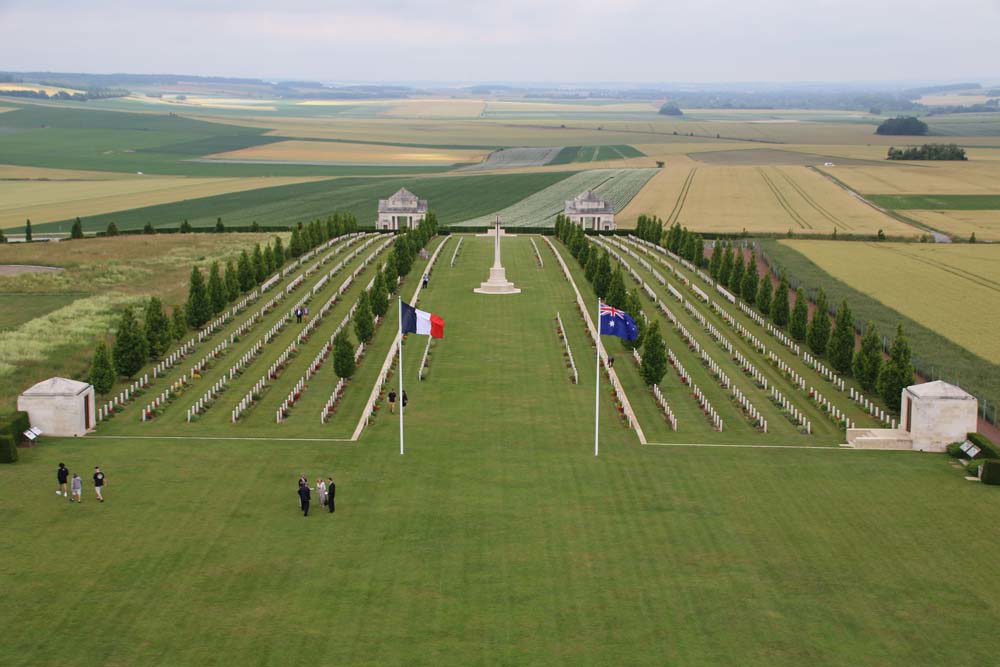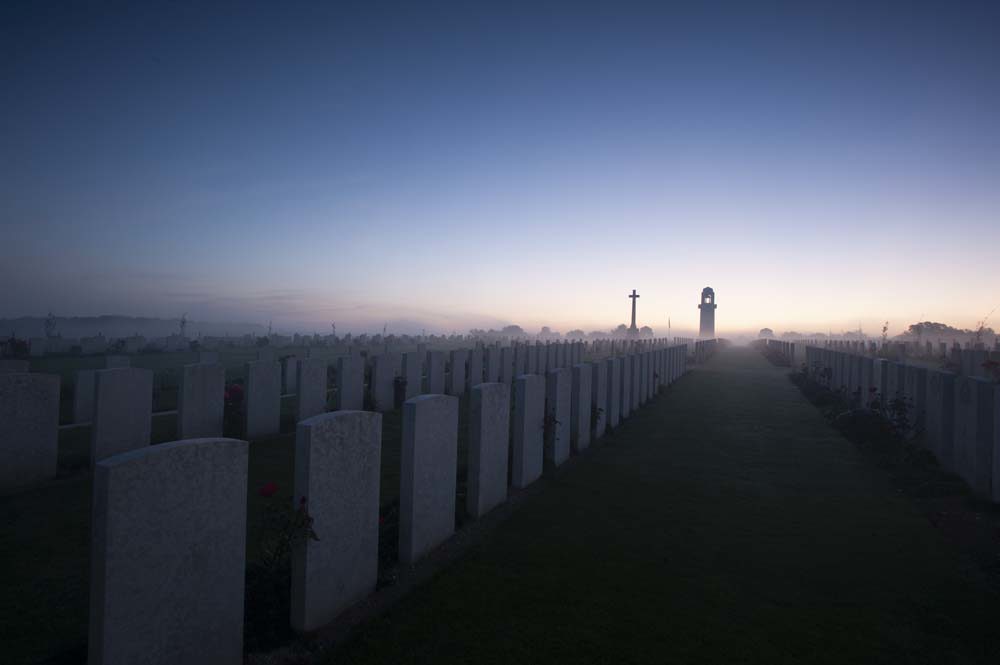28 March 2023
The Battle of Villers-Bretonneux: How Australian troops halted the German advance
Germany’s Operation Michael thundered into Allied lines in April 1918. Here’s how Australian troops at the Battle of Villers-Bretonneux helped stop it in its tracks.
Battle of Villers-Bretonneux
The Western Front in early 1918
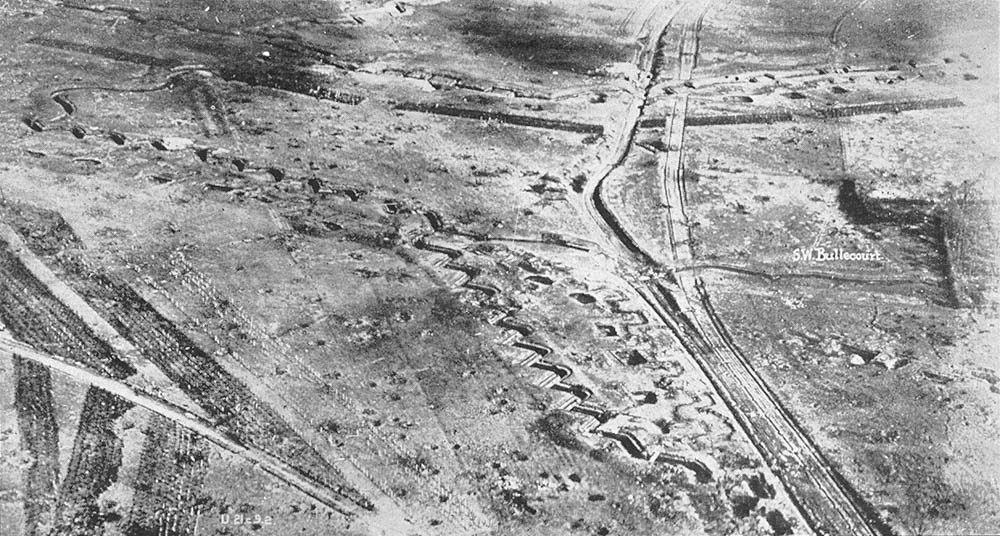
The classic view of the Western Front, here of the German Hindenburg Line: trenches; shell craters; barbed wire (Wikimedia Commons)
Even after years of gruelling fighting, and millions of spent lives, stalemate reigned on the Western Front at the beginning of 1918.
Many attempts to break the deadlock had taken place since fighting began between France, The British Empire and their allies with Imperial Germany and its supporters in August 1914.
France and Belgium’s once-green fields had been turned into a maze of trenches, craters, and blasted open spaces. Millions of young men and women had lost their lives.
No army had yet to achieve that final decisive breakthrough and win the war.
The Spring Offensive
 Image: Map of the German Army's Spring Offensive of early 1918 (Wikimedia Commons)
Image: Map of the German Army's Spring Offensive of early 1918 (Wikimedia Commons)
German High Command believed it had the answer.
In November 1917, General Ludendorff and his generals devised a huge attack across the Western Front.
The Kaiserschlacht (Kaiser’s Battle), known as the Spring Offensive, would take place in March-April 1918.
In a series of operations, the German Army would smash through the weakened British frontline, spearheaded by a new breed of highly trained soldiers: the fearsome Stormtroopers.
Operation Michael was the first phase of the Spring Offensive. Its goal was to break through British positions along the Somme. If successful, the Germans could split the Allied lines and possibly knock the British out of the war permanently.
A series of important locations lay within Operation Michael’s path, including Arras and Amiens. Controlling these cities was very important for the overall control of supplies and communications.
The villages and conurbations around Arras and Amiens would turn into battlefields when Operation Michael was launched in May 1918. One of these was Villers-Bretonneux.
Where is Villers-Bretonneux and why was it important during World War One?
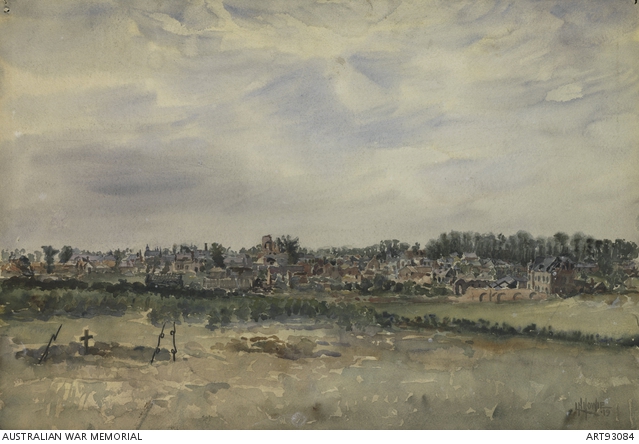
A 1916 watercolour of Villers-Bretonneux from war artists Laurence Howie. Notice the war grave in the foreground. (ART93084 AWM)
Today, under 5,000 people live in the modest village of Villers-Bretonneux.
The townsfolk drift in and out of the village’s boutiques and bistros, its schools and shopping centre, just getting on with the general business of being alive.
In April 1918, however, Villers-Bretonneux was anything but peaceful.
Villers-Bretonneux lies around 23 kilometres to the east of Amiens in the Somme department of Northern France.
Amiens was one of the most important communication and logistics hubs in the Somme region during the Great War. Capturing Villers-Bretonneux would put Amiens within range of German guns.
The village could also be used as a staging area should the German Army wish to launch a major assault on Amiens – something unthinkable for Allied military planners.
Holding Villers-Bretonneux was incredibly important.
British troops held this section of the line along with support from troops around the world. Amongst the forces arrayed to defend Villers-Bretonneux were the ANZACS.
Who were the ANZACs?
 Image: A 1915 ANZAC recruitment poster (Wikimedia Commons)
Image: A 1915 ANZAC recruitment poster (Wikimedia Commons)
Australian and New Zealand forces were known as ANZACs during World War One.
ANZAC stands for Australian and New Zealand Army Corps, the original unit formed of antipodean men and women. ANZAC has become a catch-all term for Aussie and Kiwi units throughout the Great War.
ANZAC service personnel from these nations served in combat theatres across the world.
From the Battle of Beersheba in present-day Israel to titanic set-piece battles on the Western Front, Aussies and Kiwis fought in some of the war’s most storied actions.
The most famous is 1915’s ill-fated Gallipoli Campaign, a series of ambitious amphibious landings in the Dardanelles, Turkey.
On the Western Front, ANZAC soldiers were involved in many key engagements.
The two battles at Villers-Bretonneux were amongst them.
The First Battle of Villers-Bretonneux
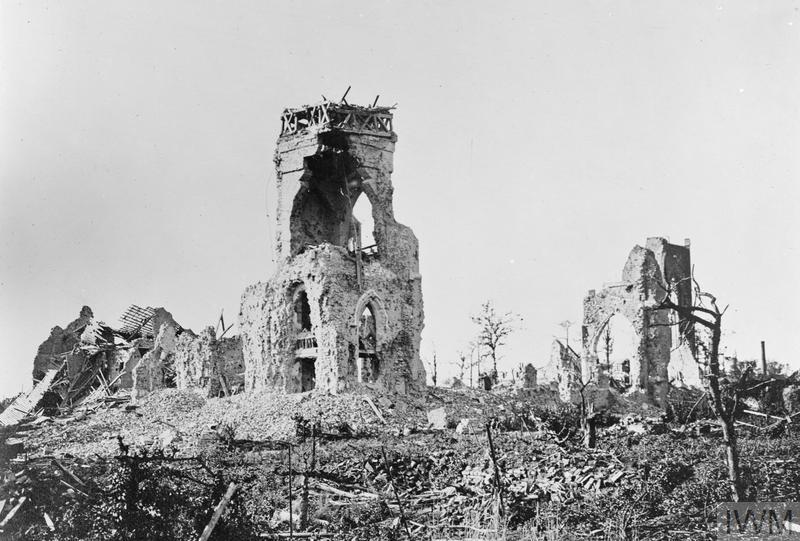
Villers-Bretonneux's ruined church tower (© IWM Q 58389)
On 21st March 1918, Operation Michael smashed a tidal wave of German men and steel into British positions across the Somme.
Australian soldiers from the 9th Australian Brigade, split into four battalions, had been transferred to the Somme sector to help their beleaguered British comrades. Gaps in the line which could have otherwise been exploited by an Imperial German advance had been filled but the fighting was still extremely tough.
With German engineers extending the railway route down to Villers-Bretonneux, the village’s protection was a top priority. Amiens could not be allowed within range of German artillery.
On 4th April 1918, the first attack on Villers-Bretonneux was launched, following the 30th March assault on the nearby village of Le Hamel.
Germans had managed to force the British out of La Hamel with Australian troops circling around to avoid envelopment and plug the hole in the line.
By the 4th, the British 14th (Light) Division and 18th (Eastern) Division and 35th Australian Battalion were holding Villers-Bretonneux, alongside the 15th Australian Brigade.
 Image: Australian troops at rest (Wikimedia Commons)
Image: Australian troops at rest (Wikimedia Commons)
In the afternoon of the 4th, the Germans continued to push hard against the village with the 18th (Eastern) Division bearing the brunt of the assault.
Villers-Bretonneux was beginning the buckle. At one point, German soldiers came within just 400 metres of the once peaceful village.
Colonel Goddard, in charge of the 35th Australian Battalion and this stretch of the line, quickly ordered a bold counterattack.
The 36th Australian Battalion lead the charge, supported by a company from the 35th and British troops from the 6th Battalion London Regiment.
The spectacular charge not only halted the Germans massing outside Villers-Bretonneux but eventually drove them back to their original starting positions. Flanking manoeuvres from Australian and British cavalry helped consolidate the 36th Australian Battalion’s gains.
For now, Villers-Bretonneux remained in Allied hands. The First Battle of Villers-Bretonneux was over – but Operation Michael would keep raging until the end of April.
The Second Battle of Villers-Bretonneux
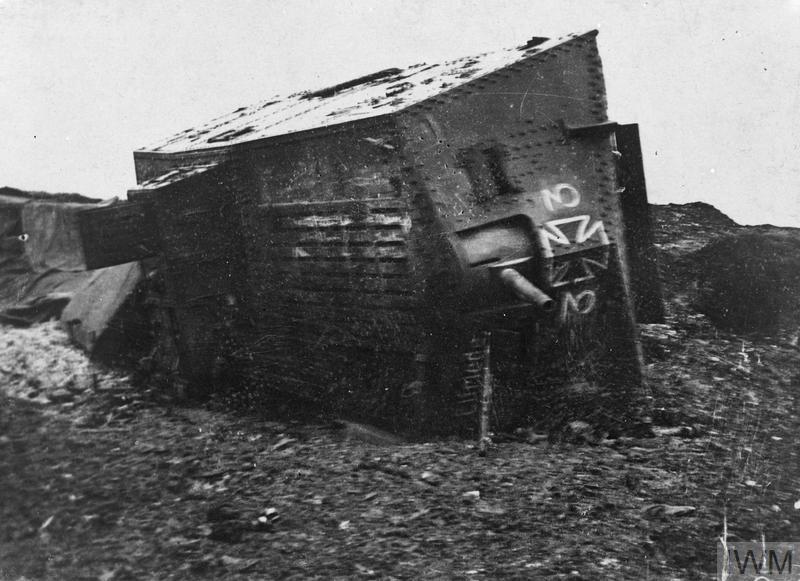
A7V Tank Elfriede on its side after being taken out by Allied tanks at Villers-Bretonneux (© IWM Q 80026)
Dawn on the 24th of April 1918.
Outside Villers-Bretonneux, behind the German lines, the rumblings of massive engines resonate from the bellies of metal beasts. Slowly, but surely, the vast metallic bulk of 13 German A7X tanks grind across No Man’s Land.
Following in the wake of the German armour come the wiry figures of German infantry.
The combined arms assault initially succeeds. The German tanks and soldiers punch a nearly five-kilometre hole in Allied lines. Villers-Bretonneux is engulfed.
British and Australian soldiers were pushed out of the village, its vital rail connection to Amiens now in enemy hands.
To protect further rail nodes and switch lines from falling into enemy hands, the Royal Tank Corps was ordered to push up to Cachy. Their orders were to hold the railway here at all costs.
Three British Mark IV tanks plus seven new light Whippet tanks were dispatched. Two of the Mark IVs were “female” variants, armed with machine guns to combat infantry. One was a “male”, equipped with two 6-pounder guns.
The first mass tank attack had taken place in November 1917 at Cambrai but was a clash of man versus machine. Soon the world’s first tank-on-tank battle began.
German A7V tank Nixe fired on the two female Mark IVs leaving them hole-marked and the crew exposed. The females pulled back, allowing the Male tank to bring its bigger gun to bear on its German opponent.
The British tank, commanded by Lieutenant Frank Mitchell, scored 3 hits, rocking Nixe onto its side, causing it to keel over. The German tank crew escaped but many were gunned down as they attempted to get away.
Next, Mitchell and is tank came under fire from two A7Vs although Mitchell’s ranging shots managed to scare off the two incoming tanks. Mitchell instead his attention to the infantry.
Supported by the more manoeuvrable Whippets, the British tanks were able to move in on several German battalions forming up and preparing to move out. Many opposing infantrymen were cut down.
With Mitchell and his Mark IV being the only large tank left on the battlefield, he quickly became a large target. With shells falling nearby and bullets pinging off the hull, Mitchell and his tank fell back.
The first tank-on-tank skirmish the world has seen had been won by the British.
Australian troops later captured an A7V called Mephisto and took her back to Queensland as spoils of war.
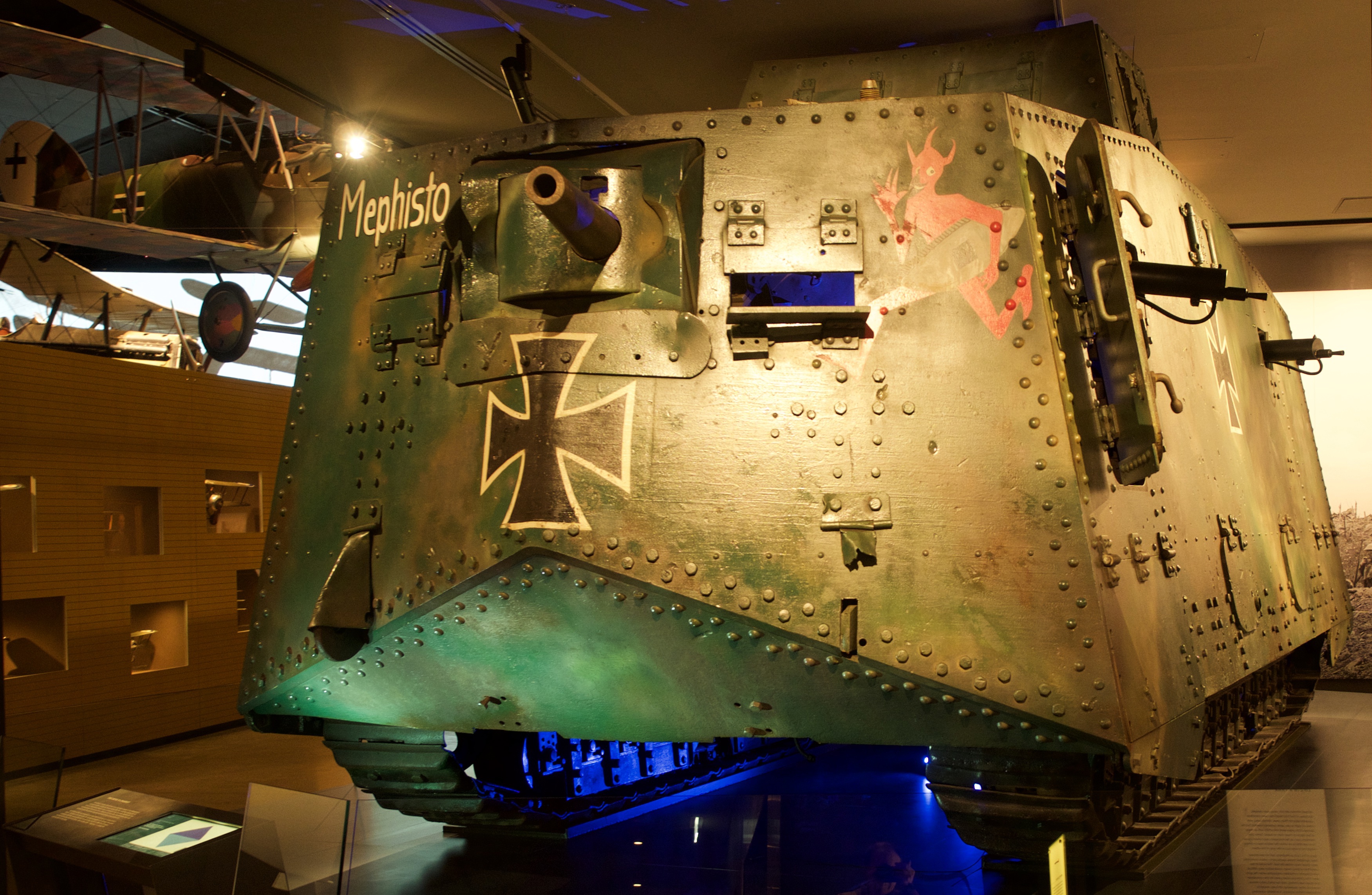
Mephisto in her current home at the Australian War Memorial in Canberra. She was taken back to Australia by ANZAC troops after the Villers-Bretonneux victory (Wikimedia Commons)
The Australians counterattack
Even with the efforts of the Royal Tank Corps to slow the Germans, Villers-Bretonneux was still in German hands by the evening of April 24th, 1918.
On the morning of the 24th, an attack was ordered by British General Henry Rawlinson to retake the village.
The men selected to lead the Allied counter were the Australian 13th and 15th Brigades under Brigadier-General Thomas William Glasgow and H.E. “Pompey” Elliot respectively. Support came from Northamptonshire Regiment and Durham Light Infantry as well as the French Moroccan Division.
While the Germans decided to attack during the day, the Allied retaliation would come after dark.
22.00 on the night of the 24th of April 1918. Around Villers-Bretonneux mass the men of the 5th Australian Division in their respective brigades and battalions. Their aim was to flank and envelope Villers-Bretonneux, cutting off its German occupiers, and recapturing the village.
At first, German machine gunners were given rich pickings. Visibility for the defenders was still high enough to cut a swathe through the charging Aussies. However, a series of charges against machine-gun posts, such as those led by Victoria Cross-winner Lieutenant Clifford Saddler, soon silenced the guns.
 Image: Two Aussie soldiers preparing a trench mortar during the Second Battle of Villers-Bretonneux (© IWM E(AUS) 2677)
Image: Two Aussie soldiers preparing a trench mortar during the Second Battle of Villers-Bretonneux (© IWM E(AUS) 2677)
The 13th and 15th Brigades soon swept around Villers-Bretonneux, applying huge pressure to the defenders.
As night drew thicker, the Aussies struggled to link up effectively amidst the gloom. Many Imperial German soldiers were able to slip away down a railway cutting before the full envelopment could occur.
Once the sun’s rays began to fall on Villers-Bretonneux as dawn rose across the Western Front, the gap was filled. The Australian brigades had joined up, trapping those German soldiers that remained.
The British units then attacked the remaining German positions while the Australians tightened the noose.
The French Moroccan unit played an important role in the victory at Villers-Bretonneux, rescuing the 51st and 52nd Australian Battalions whose attack was stalling south of the village.
On the morning of the 25th of April, Villers-Bretonneux was held by the Imperial German Army; by the end of the day, it was back in Allied hands.
The Australian’s actions at Villers-Bretonneux gained them massive plaudits. A quickly prepared across on unknown, uneven ground by men given scant hours to prepare should have been a recipe for disaster. Instead, it was a brilliant attacking move executed with great skill and courage.
As Brigadier-General George Grogan of the 23rd British Bridge succinctly put it:
“Perhaps the greatest individual feat of the war – the successful counter-attack by night across unknown and difficult ground, at a few hours’ notice, by the Australian soldier.”
It’s all the more fitting that the Australian-led attack took place on the 25th of April. In 1918, it marked three years to the day that ANZAC troops had made their name on the blood-soaked sands of Gallipoli.
25th of April is commemorated as ANZAC Day in Australia and New Zealand every year. It marks the courage and sacrifice of Australian, New Zealand, Aboriginal and Torres Strait personnel made during the World Wars.
Casualties of Villers-Bretonneux
As with many World War One battles, the fighting at Villers-Bretonneux was a bloody affair.
Of the 3,500 men of the 9th Australian Brigade who led the counter at the First Battle, 2,400 were killed, captured, or wounded.
Across both battles, British and Australian losses were just shy of 13,000 men. French casualties totalled 3,500 whereas their German opponents suffered between 8,000-10,500 men killed, captured, or wounded.
At the Commonwealth War Graves, it’s our job to commemorate the casualties of Villers-Bretonneux.
We maintain several sites around the former Great War battlefield. Here, the war graves or names of the fallen are cared for in perpetuity so their actions and sacrifice are never forgotten.
Villers-Bretonneux Australian National Memorial
Close to 11,000 World War One Australian casualties are commemorated on the Villers-Bretonneux Australian National Memorial. Those listed on its name panels have no known grave.
The Australian government first conceived a permanent memorial to its fallen in the 1920s. The original design brief required Australian stone for use in the memorial. This idea proved prohibitively expensive.
After a 1935 visit to Australia by Commission founder Sir Fabian Ware, the current design from Sir Edwin Lutyens was used.
Villers Bretonneux was the last of the great World War One memorials to the missing to be built in France upon its unveiling in July 1938. King George V and his wife Queen Elizabeth led the unveiling.
The King, whose words were broadcast to Australia, closed his speech with:
“The rest in peace while over them all Australia’s tower keeps watch and ward.”
Villers-Bretonneux Military Cemetery
More than 2,000 Commonwealth soldiers, including ANZAC servicemen, are buried at Villers-Bretonneux Military Cemetery. 1,500 of these war graves are identified casualties, 700 of which are Australian.
Villers-Bretonneux Military Cemetery, like the memorial, was designed by Commission architect Sir Edwin Lutyens.
Like many large-scale Commission cemeteries, Villers-Bretonneux took in burials from nearby smaller cemeteries or makeshift burial grounds when it was established post-1918 Armistice.
Ten or so locations had burials moved into Villers-Bretonneux. The largest single amount of war graves came from Dury Military Hospital Cemetery. More than 400 graves were bought in from Dury.
The Villers-Bretonneux Memorial stands within the grounds of the military cemetery.
More information on the ANZAC Great War experience can be found at the Sir John Monash Centre, located just behind the memorial.
Please note: The Monash Centre is not operated by the Commonwealth War Graves Commission.
Leaving a legacy Stronger than stone
The ANZAC action at the Second Battle of Villers-Bretonneux forged a strong bond between the villagers and their Australian liberators.
During wartime, Aussie soldiers at Villers-Bretonneux would often share their rations with the townsfolk.
After the war, communities across Australia made donations to help rebuild the shattered village. Its school, for example, was paid for by money raised by schoolchildren from Victoria, Australia. Above every blackboard sits the motto “N’oublions jamais l’Australie” (“Let us never forget Australia”).
ANZAC Day events take place on the 25th of April every year. Villers-Bretonneux is even twinned with Robinvale, Victoria, Australia in a mark of respect.
Discover the stories of the Commonwealth’s war dead
The stories of the men who fell at Villers-Bretonneux are waiting for you to discover them. You can do that with our Find War Dead tool.
You can search by name, regiment, rank and many more metrics to help refine your search.
Want to know where they’re buried or want to visit one of our sites? Use our Find War Memorials and Cemeteries search tool to find a site to suit you.




